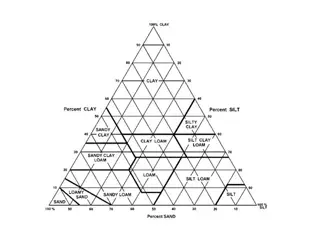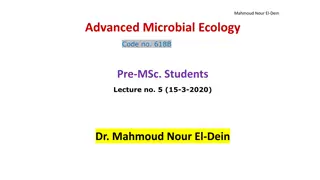
Agriculture Soil Sampling and Testing Market: Thriving Research Methodology
In modern agriculture, soil health plays a pivotal role in determining crop productivity, sustainability, and environmental stewardship. Agriculture Soil Sampling and Testing Market have emerged as essential practices for farmers and agronomists seeking to optimize soil fertility, nutrient management, and crop yields.
Uploaded on | 5 Views
Download Presentation

Please find below an Image/Link to download the presentation.
The content on the website is provided AS IS for your information and personal use only. It may not be sold, licensed, or shared on other websites without obtaining consent from the author. If you encounter any issues during the download, it is possible that the publisher has removed the file from their server.
You are allowed to download the files provided on this website for personal or commercial use, subject to the condition that they are used lawfully. All files are the property of their respective owners.
The content on the website is provided AS IS for your information and personal use only. It may not be sold, licensed, or shared on other websites without obtaining consent from the author.
E N D
Presentation Transcript
Agriculture Soil Sampling and Testing Market: Thriving Research Methodology by BIS Research In modern agriculture, soil health plays a pivotal role in determining crop productivity, sustainability, and environmental stewardship. Agriculture Soil Sampling and Testing Market have emerged as essential practices for farmers and agronomists seeking to optimize soil fertility, nutrient management, and crop yields. Importance of Soil Sampling and Testing Soil serves as the foundation of agriculture, providing essential nutrients, water, and support for plant growth. However, soil properties can vary significantly within a field, necessitating precise assessment and management strategies. Soil sampling involves systematically collecting soil samples from different locations within a field, while soil testing entails analyzing these samples for key parameters such as pH, nutrient levels, organic matter content, and soil texture. The insights derived from soil testing inform farmers' decisions regarding fertilizer application, irrigation scheduling, and crop selection, enabling them to optimize resource use and enhance productivity while minimizing environmental impact. Access More: Download FREE detailed sample report on Agriculture Soil Sampling and Testing Market Research. Market Growth Drivers Several factors are driving the growth of the agriculture soil sampling and testing market: Increasing Awareness of Soil Health: Growing recognition of the importance of soil health and its impact on crop productivity and sustainability is driving demand for soil testing services. Farmers are becoming increasingly aware of the need to assess and manage soil fertility, pH levels, and nutrient deficiencies to optimize yields and minimize input costs. Adoption of Precision Agriculture Technologies: The advent of precision agriculture technologies, including GPS-guided soil sampling and variable rate application systems, has bolstered the demand for soil sampling and testing services. These technologies enable farmers to
precisely target inputs based on site-specific soil conditions, leading to more efficient resource utilization and improved crop performance. Regulatory Requirements and Environmental Concerns: Regulatory mandates related to nutrient management, water quality protection, and sustainable agriculture practices are driving the adoption of soil testing services. Government initiatives aimed at promoting soil conservation, reducing nutrient runoff, and mitigating environmental pollution are incentivizing farmers to prioritize soil health and adopt soil testing as a best management practice. Technological Advancements in Testing Methods: Advancements in soil testing technologies, such as portable soil testing kits, rapid analysis techniques, and digital soil mapping tools, are expanding the capabilities and accessibility of soil testing services. These innovations enable real- time, on-site soil analysis, providing farmers with timely and actionable insights for decision- making. Market Trends and Opportunities Several trends are shaping the agriculture soil sampling and testing market: Digitalization and Data Integration: The integration of soil testing data with digital farm management platforms and agronomic decision support systems is enabling farmers to make data- driven decisions and optimize input use efficiency. Data analytics tools are being leveraged to interpret soil test results, generate nutrient recommendations, and track soil health trends over time, facilitating precision nutrient management strategies. Expansion of Soil Health Assessment Services: Beyond traditional nutrient analysis, soil testing laboratories are offering comprehensive soil health assessment services that encompass physical, chemical, and biological properties of soil. These holistic assessments provide a more nuanced understanding of soil quality, resilience, and sustainability, empowering farmers to adopt regenerative agriculture practices and improve long-term soil health. Adoption of Remote Sensing and Geospatial Technologies: Remote sensing techniques, such as satellite imagery and aerial drones, are being integrated with soil sampling and testing practices to enhance spatial mapping and monitoring of soil properties at a landscape scale. Geospatial analysis tools enable farmers to identify soil variability patterns, delineate management zones, and prioritize areas for targeted soil sampling and intervention, optimizing resource allocation and management practices. Emphasis on Soil Health Education and Outreach: Agricultural extension programs, soil conservation organizations, and industry stakeholders are actively promoting soil health education and outreach initiatives to raise awareness among farmers about the benefits of soil testing and sustainable soil management practices. Training workshops, field demonstrations, and online resources are being deployed to empower farmers with the knowledge and tools needed to assess and improve soil health on their farms. Future Market Outlook The Agriculture Soil Sampling and Testing Industry is poised for continued growth and innovation as the importance of soil health in sustainable agriculture becomes increasingly evident. Technological advancements, regulatory pressures, and shifting consumer preferences are expected to drive demand for soil testing services and solutions. By harnessing the power of soil data and adopting evidence-based soil management practices, farmers can enhance productivity, profitability, and environmental stewardship in the years to come.






















